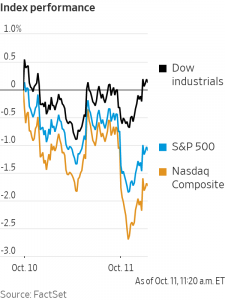Nasdaq Falls Into Bear Market After Volatile Day
Inflation data due Thursday will show whether the Fed’s rate increases are taming consumer prices
U.S. stocks and the British pound turned lower Tuesday following Bank of England Gov. Andrew Bailey’s remark that the U.K. central bank’s plan to rescue pension funds hit by interest-rate increases will end as scheduled Friday.

Major U.S. stock indexes were mixed following the remarks, made at the Institute for International Finance’s annual meeting in Washington D.C., reversing a rally of about 0.8% in the S&P 500. The Dow was modestly higher and the Nasdaq Composite was down 1.1%, returning the tech-heavy index to a “bear market,” or a decline of 20% or more from a recent peak.
The comments were taken as negative on Wall Street because they raise the prospect of further asset sales by U.K. pension funds in the face of large interest-rate increases.
The program of bond buys launched Sept. 28 had been intended to give the funds a “window of opportunity” to sell assets in an orderly fashion, but Mr. Bailey said that opportunity would end on Oct. 14.
Stocks had opened lower, then turned higher at midday. They reversed course in the final hour of trading after Mr. Bailey’s comments.
“You’ve got three days left,” Mr. Bailey said in remarks addressed to pension funds. “You’ve got to get this done.”
The Dow’s performance was aided by big gains in Amgen Inc. The biotech stock jumped 6%, making it the best performer in the Dow on Tuesday. Shares of biotech companies helped power the other indexes higher, too, with the Nasdaq Biotechnology Index rising more than 2% in recent trading.
Investors have been grappling throughout the year with the effects of decades-high inflation and the Federal Reserve’s attempts to tame it with higher interest rates. For many, the concerns have grown deeper in recent weeks as inflation remains stubbornly high and traders worry that the Fed will cool the economy so much that it tips into a recession.
“The question now is not if there will be a recession, it’s when and how bad,” said Justin Wiggs, managing director in equity trading at Stifel Nicolaus. One week ago, traders were cheering the biggest two-day rally in the Dow and S&P 500 in two years, but stocks have fallen steadily since then. Both the Dow and the S&P 500 remain in bear markets.
U.S. inflation data due Thursday will show whether the Fed’s sizeable interest-rate rises are working to tame soaring consumer prices. A larger-than-forecast rise could bolster expectations that Fed officials will opt for another supersize 0.75 percentage point increase at their next meeting.
Meanwhile, investors are bracing for the first wave of major corporate earnings reports due this week, which are expected to show companies struggling with high rates and weakening consumer demand. PepsiCo reports Wednesday while financial titans such as BlackRock, JPMorgan Chase and Morgan Stanley report later in the week.
“First-quarter and second-quarter earnings came in remarkably well. The third quarter may be the pivot point at which we see earnings cannot keep growing to the sky, and that companies are subject to the economic headwinds we are facing from all kinds of directions,” said David Donabedian, chief investment officer at CIBC Private Wealth US.
And what’s even more important than third-quarter results, some investors say, is the guidance corporate leaders give about next year.
Some traders said Tuesday’s midday bounce higher was not so much a sign of strength, but rather a sign of so-called short covering. Some traders make money by betting that stocks are headed lower. To do so, they borrow shares and sell them, hoping to profit by buying these shares back at a lower price at a later date. When stocks start to climb, those gains can be accelerated by short sellers covering their bets by buying shares.
Yields on benchmark U.S. government bonds continued their ascent, coming within sight of the 4% level. The yield on the benchmark 10-year Treasury note rose to 3.938%, its second highest level of the year, from 3.883% on Friday. The U.S. bond market was closed Monday for the Columbus Day holiday.
In commodity markets, oil weakened as concerns about the economy returned to the fore. Prices rose last week after the Organization of the Petroleum Exporting Countries and its Russia-led allies agreed to slash their output. On Tuesday, Brent crude, the international oil benchmark, shed 2% to $94.29 a barrel.
Overseas indexes slumped. In Japan, the Nikkei 225 fell 2.6%. Hong Kong’s Hang Seng closed 2.2% lower, hitting its lowest level in more than a decade.
In Europe, the pan-continental Stoxx Europe 600 fell 0.6%, led by losses among its oil-and-gas and chemicals companies.
 Copyright 2020, Dow Jones & Company, Inc. All Rights Reserved Worldwide. LEARN MORE
Copyright 2020, Dow Jones & Company, Inc. All Rights Reserved Worldwide. LEARN MORE
This stylish family home combines a classic palette and finishes with a flexible floorplan
Just 55 minutes from Sydney, make this your creative getaway located in the majestic Hawkesbury region.
As Paris makes its final preparations for the Olympic games, its residents are busy with their own—packing their suitcases, confirming their reservations, and getting out of town.
Worried about the hordes of crowds and overall chaos the Olympics could bring, Parisians are fleeing the city in droves and inundating resort cities around the country. Hotels and holiday rentals in some of France’s most popular vacation destinations—from the French Riviera in the south to the beaches of Normandy in the north—say they are expecting massive crowds this year in advance of the Olympics. The games will run from July 26-Aug. 1.
“It’s already a major holiday season for us, and beyond that, we have the Olympics,” says Stéphane Personeni, general manager of the Lily of the Valley hotel in Saint Tropez. “People began booking early this year.”
Personeni’s hotel typically has no issues filling its rooms each summer—by May of each year, the luxury hotel typically finds itself completely booked out for the months of July and August. But this year, the 53-room hotel began filling up for summer reservations in February.
“We told our regular guests that everything—hotels, apartments, villas—are going to be hard to find this summer,” Personeni says. His neighbours around Saint Tropez say they’re similarly booked up.
As of March, the online marketplace Gens de Confiance (“Trusted People”), saw a 50% increase in reservations from Parisians seeking vacation rentals outside the capital during the Olympics.
Already, August is a popular vacation time for the French. With a minimum of five weeks of vacation mandated by law, many decide to take the entire month off, renting out villas in beachside destinations for longer periods.
But beyond the typical August travel, the Olympics are having a real impact, says Bertille Marchal, a spokesperson for Gens de Confiance.
“We’ve seen nearly three times more reservations for the dates of the Olympics than the following two weeks,” Marchal says. “The increase is definitely linked to the Olympic Games.”

Getty Images
According to the site, the most sought-out vacation destinations are Morbihan and Loire-Atlantique, a seaside region in the northwest; le Var, a coastal area within the southeast of France along the Côte d’Azur; and the island of Corsica in the Mediterranean.
Meanwhile, the Olympics haven’t necessarily been a boon to foreign tourism in the country. Many tourists who might have otherwise come to France are avoiding it this year in favour of other European capitals. In Paris, demand for stays at high-end hotels has collapsed, with bookings down 50% in July compared to last year, according to UMIH Prestige, which represents hotels charging at least €800 ($865) a night for rooms.
Earlier this year, high-end restaurants and concierges said the Olympics might even be an opportunity to score a hard-get-seat at the city’s fine dining.
In the Occitanie region in southwest France, the overall number of reservations this summer hasn’t changed much from last year, says Vincent Gare, president of the regional tourism committee there.
“But looking further at the numbers, we do see an increase in the clientele coming from the Paris region,” Gare told Le Figaro, noting that the increase in reservations has fallen directly on the dates of the Olympic games.
Michel Barré, a retiree living in Paris’s Le Marais neighbourhood, is one of those opting for the beach rather than the opening ceremony. In January, he booked a stay in Normandy for two weeks.
“Even though it’s a major European capital, Paris is still a small city—it’s a massive effort to host all of these events,” Barré says. “The Olympics are going to be a mess.”
More than anything, he just wants some calm after an event-filled summer in Paris, which just before the Olympics experienced the drama of a snap election called by Macron.
“It’s been a hectic summer here,” he says.

AFP via Getty Images
Parisians—Barré included—feel that the city, by over-catering to its tourists, is driving out many residents.
Parts of the Seine—usually one of the most popular summertime hangout spots —have been closed off for weeks as the city installs bleachers and Olympics signage. In certain neighbourhoods, residents will need to scan a QR code with police to access their own apartments. And from the Olympics to Sept. 8, Paris is nearly doubling the price of transit tickets from €2.15 to €4 per ride.
The city’s clear willingness to capitalise on its tourists has motivated some residents to do the same. In March, the number of active Airbnb listings in Paris reached an all-time high as hosts rushed to list their apartments. Listings grew 40% from the same time last year, according to the company.
With their regular clients taking off, Parisian restaurants and merchants are complaining that business is down.
“Are there any Parisians left in Paris?” Alaine Fontaine, president of the restaurant industry association, told the radio station Franceinfo on Sunday. “For the last three weeks, there haven’t been any here.”
Still, for all the talk of those leaving, there are plenty who have decided to stick around.
Jay Swanson, an American expat and YouTuber, can’t imagine leaving during the Olympics—he secured his tickets to see ping pong and volleyball last year. He’s also less concerned about the crowds and road closures than others, having just put together a series of videos explaining how to navigate Paris during the games.
“It’s been 100 years since the Games came to Paris; when else will we get a chance to host the world like this?” Swanson says. “So many Parisians are leaving and tourism is down, so not only will it be quiet but the only people left will be here for a party.”
This stylish family home combines a classic palette and finishes with a flexible floorplan
Just 55 minutes from Sydney, make this your creative getaway located in the majestic Hawkesbury region.






















